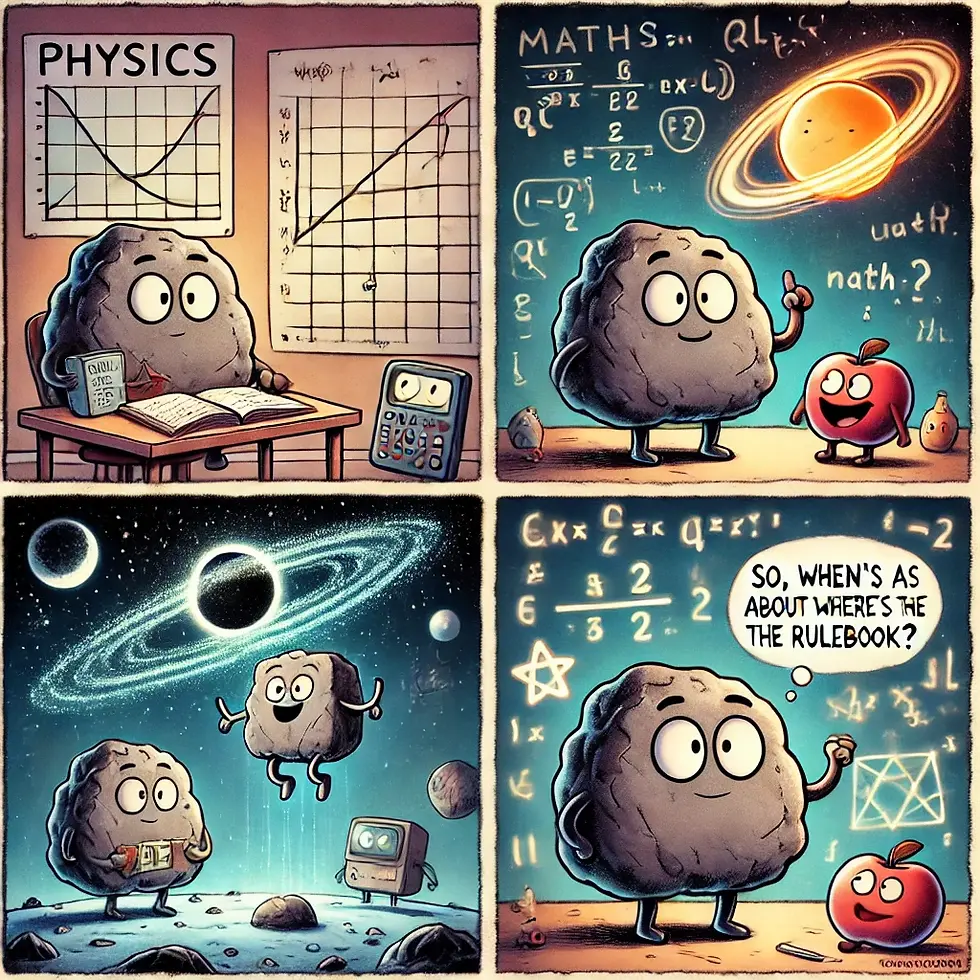Maths & Physics The Production: The Universe’s Blueprint
- amcm collaborator
- Dec 11, 2024
- 4 min read

From abstract equations to the laws of nature, discover the interconnected story of two sciences that define our reality.
Vectors in Mathematics: An Overview
Vectors are fundamental objects in mathematics that possess both magnitude and direction, often visualised as arrows in space. These are widely used to describe physical quantities such as velocity, force, and displacement, providing a bridge between pure mathematics and applied sciences.
The formal concept of vectors was developed in the 19th century by figures like Hermann Grassmann, William Rowan Hamilton, and Josiah Willard Gibbs. These pioneers laid the groundwork for modern vector calculus, essential for understanding physical phenomena across multiple dimensions.
The term “vector” originates from the Latin vector, meaning “carrier” or “conveyor.” Hamilton first introduced the term in the mid-19th century, but Gibbs and Oliver Heaviside advanced its modern interpretation, creating tools like the gradient, divergence, and curl for analysing vector fields. These tools revolutionised fields such as electromagnetism and fluid dynamics transformations : Shaping Space and Structure
Transformations are operations that alter the position, orientation, or size of objects in space. Common types include:
Translations: Moving an object without rotation.
Rotations: Turning an object about a point or axis.
Reflections: Flipping an object over a line or plane.
Scaling: Changing the size of an object while preserving its shape.
These operations are integral to geometry, physics, computer graphics, and more. The formal study of transformations, particularly in the context of group theory, emerged through the works of mathematicians such as Évariste Galois, Arthur Cayley, and Sophus Lie in the 19th and 20th centuries.
Analysis and Transformations
1. Josiah Willard Gibbs
An American mathematician and physicist, Gibbs made significant contributions to vector analysis and thermodynamics. His systematic approach to vectors in the late 19th century established the framework for analysing vector quantities in engineering and physics .
2. Oliver Heaviside
An engineer, Heaviside introduced mathematical techniques that simplified Maxwell’s equations in electromagnetism. His contributions included vector operators such as divergence and curl, vital tools for understanding vector fields in physics .
3. Évariste Galois
Galois’s work on group revolutionised the mathematical understanding of symmetry, laying the foundation for analysing transformations and their algebraic structures .
4. Sophus Lie
Lie’s development of continuous transformation groups, now known as Lie groups, provided a framework for analysing symmetries in geometry and differential equations, with profound implications in physics and mathematics .
Electromagnetic Fields and Broadcasting Spectrums Across Different Disciplines & Context
Electromagnetic fields and broadcasting spectrums are crucial across various scientific and technological domains. While their definitions and applications vary, they serve as fundamental components in disciplines ranging from classical physics to quantum theory.
1. Information Communication Technology (ICT):
In ICT, electromagnetic fields are described in terms of electromagnetic waves that carry information through the transmission of electromagnetic radiation. Broadcasting spectrums refer to the range of frequencies allocated for various communication purposes, such as radio, television, mobile phones, & Wi-Fi. Entities in this context could refer to data packets, signals, or information transmitted & received through these spectrums.
2. Classical Physics:
In classical physics, electromagnetic fields are described by Maxwell's equations, which govern the behaviour of electric & magnetic fields. Electromagnetic waves are seen as continuous phenomena characterised by their frequency, wavelength, & amplitude. Broadcasting spectrums are understood in terms of the range of frequencies over which electromagnetic waves propagate, from radio waves to gamma rays.
3. Quantum Physics:
In quantum physics, electromagnetic fields are quantised, meaning they consist of discrete units called photons. Quantum mechanics describes the behaviour of photons & their interactions with matter. Broadcasting spectrums are still defined in terms of frequencies, but the quantised nature of electromagnetic fields introduces phenomena such as particle-wave duality & energy quantisation.
4. Theoretical Physics:
Theoretical physics encompasses both classical & quantum descriptions of electromagnetic fields & broadcasting spectrums, depending on the specific context of the research. Theoretical physicists may explore fundamental questions about the nature of electromagnetic interactions, the unification of electromagnetic forces with other fundamental forces & the behaviour of electromagnetic fields in extreme conditions, such as near black holes or in the early universe.
5. Thermodynamics:
In thermodynamics, electromagnetic fields play a role in describing heat transfer mechanisms, such as radiation. Thermodynamics may also consider the entropy associated with electromagnetic radiation & its effects on the overall thermodynamic behaviours of systems. However, broadcasting spectrums are not typically a focus in traditional thermodynamics, unless considering specific applications like thermal imaging or radiative heat transfer.
Conclusion
From the elegant abstraction of vectors and transformations to the real-world applications of electrields and broadcasting spectrums, mathematics and physics intersect in fascinating and profound ways. The evolution of these concepts reflects humanity’s continuous quest to decode the laws of nature and harness them for technological advancement.
References
1. Michael Crowe, A History of Vector Analysis: The Evolution of the Idea of a Vectorial System.
2. J. Willard Gibbs, Elementary Principles in Statistical Mechanics.
3. Felix Klein, Erlangen Program.
4. Évariste Galois, Galois Theory.
5. Oliver Heaviside, Electromagnetic Theory.
6. Maxwell, James Clerk, A Treatise on Electricity and Magnetism.
7. Sophus Lie, The Theory of Transformation Groups.
8. Roger Penrose, The Road to Reality: A Complete Guide to the Laws of the Universe.
9. ITU Guidelines on Spectrum Management.
10. Richard P. Feynman, Lectures on Physics.
11. Planck, Max, The Origin and Development of the Quantum Theory.
12. Einstein, Albert, On a Heuristic Point of View Concerning the Production and Transformation of Light.
13. Stephen Hawking, A Brief History of Time.
14. G. J. Van Wylen, Thermodynamics and Heat Power.
Comments